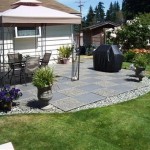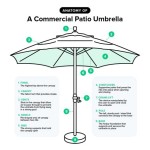Ideas To Transform Your Patio Into An Outdoor Oasis Garden
The patio, often an underutilized extension of the home, possesses the potential to become a personal sanctuary. Through thoughtful design and strategic implementation of gardening principles, a standard patio can be transformed into a vibrant outdoor oasis. This transformation involves careful consideration of space, light, climate, and personal aesthetic preferences. The goal is to create a space that is both visually appealing and functionally useful, offering respite and connection with nature.
This article dissects key ideas that facilitate the conversion of a patio into a thriving outdoor garden oasis. It explores diverse strategies, from incorporating vertical gardening techniques to selecting appropriate plants, ultimately providing a comprehensive guide to creating a personalized outdoor haven.
Maximizing Space with Vertical Gardening
For many patios, especially those in urban settings, space is a premium. Traditional horizontal gardening consumes valuable square footage, limiting mobility and potentially overwhelming the area. Vertical gardening offers an efficient and visually striking solution, allowing for the cultivation of plants without sacrificing precious floor space. This approach utilizes vertical surfaces such as walls, fences, and even structural supports to create a multilayered garden.
Several vertical gardening techniques can be implemented, each offering unique aesthetic and functional benefits. Wall-mounted planters, for example, provide a simple and versatile option for displaying small flowering plants, herbs, or succulents. These planters can be arranged in various patterns and configurations, adding visual interest to previously blank walls. Another alternative involves utilizing hanging baskets. Suspended from the patio ceiling or from strategically placed hooks, hanging baskets are ideal for trailing plants like petunias, ivy geraniums, or cascading herbs. They introduce a dynamic element to the garden, drawing the eye upward and creating a sense of depth.
Living walls, also known as green walls, represent a more elaborate form of vertical gardening. They typically consist of a framework that supports numerous small pockets or containers, each filled with soil and plants. Living walls can transform an entire patio wall into a living tapestry, creating a lush and immersive environment. While requiring more initial investment and maintenance than other vertical gardening methods, living walls offer unparalleled aesthetic impact and can contribute to improved air quality. Modular green wall systems offer a flexible and relatively easy installation option, allowing for customization and rearrangement as desired. The selection of plants for vertical gardens should consider factors such as light exposure, watering requirements, and the overall aesthetic goal. Plants with varying textures and colors can be combined to create a visually appealing and dynamic display.
Beyond the aesthetic advantages, vertical gardening offers practical benefits. It improves air circulation around plants, reducing the risk of fungal diseases. It also provides a degree of insulation, helping to regulate temperature and create a more comfortable microclimate on the patio. Furthermore, vertical gardens can serve as natural sound barriers, reducing noise pollution and enhancing privacy.
Selecting Plants for Your Patio Microclimate
The success of any patio garden hinges on the careful selection of plants that are well-suited to the specific microclimate of the space. Factors such as sunlight exposure, temperature fluctuations, and humidity levels play a crucial role in determining which plants will thrive. Understanding these conditions is essential for creating a sustainable and visually appealing garden.
Sunlight is a primary determinant of plant health and growth. Patios with full sun exposure, receiving at least six hours of direct sunlight per day, are suitable for sun-loving plants such as roses, lavender, and many flowering annuals. These plants require ample sunlight to photosynthesize effectively and produce vibrant blooms. Partial shade patios, receiving between three and six hours of direct sunlight, offer a broader range of plant options. Plants such as hydrangeas, impatiens, and hostas prefer partial shade and protection from the harsh midday sun. For patios with full shade, receiving less than three hours of direct sunlight, shade-tolerant plants such as ferns, calatheas, and begonias are the best choice. These plants have adapted to thrive in low-light conditions and will add lush greenery to shaded areas.
Temperature fluctuations can also significantly impact plant health. Patios located in areas with extreme temperature variations require plants that are either hardy enough to withstand these fluctuations or can be easily moved indoors during harsh weather. Consider using containers to facilitate the movement of sensitive plants. Choosing native plants, which are adapted to the local climate, often minimizes the need for special care and increases the chances of success. Humidity levels are another factor to consider. Plants that thrive in humid environments, such as ferns and tropical foliage, may struggle in arid climates. Conversely, plants adapted to dry conditions, such as succulents and cacti, may suffer in overly humid environments.
Beyond climate considerations, personal preferences play a crucial role in plant selection. Consider the desired aesthetic of the patio garden. For a formal garden, symmetrical arrangements and classic plant choices such as boxwood and roses may be appropriate. For a more relaxed and informal garden, a mix of textures, colors, and plant types can create a more natural and organic feel. Incorporating herbs and vegetables into the patio garden adds a functional element, allowing for the enjoyment of fresh produce grown right outside the door. Scented plants, such as lavender, jasmine, and gardenia, can enhance the sensory experience of the patio, creating a fragrant and inviting atmosphere.
Creating Ambiance with Lighting and Accessories
Beyond plants, the ambiance of a patio garden is significantly enhanced by the strategic use of lighting and accessories. These elements contribute to the overall aesthetic appeal, creating a welcoming and comfortable space for relaxation and entertainment. Thoughtful lighting extends the usability of the patio into the evening hours, while carefully chosen accessories add personality and character.
Lighting options for a patio garden are diverse, ranging from ambient lighting to task lighting. Ambient lighting provides general illumination, creating a soft and inviting glow. String lights, draped across the patio ceiling or woven through trellises, are a popular choice for ambient lighting. They add a touch of whimsy and create a festive atmosphere. Lanterns, placed on tables or hung from hooks, offer another option for ambient lighting, providing a warm and inviting glow. Solar-powered lights are an energy-efficient and eco-friendly option for illuminating pathways and garden features. Task lighting provides focused illumination for specific activities, such as reading or dining. Outdoor spotlights can be used to highlight specific plants or garden features, creating dramatic visual effects. Path lights can be used to illuminate walkways, ensuring safety and ease of navigation. Consider using a combination of different types of lighting to create a layered and dynamic lighting scheme.
Accessories play a crucial role in personalizing the patio garden and reflecting individual style. Outdoor furniture, such as comfortable seating and a dining table, is essential for creating a functional and inviting space. Choose furniture that is weather-resistant and durable, able to withstand the elements. Cushions and throw pillows add comfort and color to outdoor seating, creating a cozy and inviting atmosphere. Decorative planters and pots, in various shapes, sizes, and materials, can be used to showcase plants and add visual interest. Water features, such as fountains or small ponds, introduce the soothing sound of water, creating a tranquil and relaxing ambiance. Outdoor rugs define seating areas and add warmth and texture to the patio floor. Wind chimes and other decorative elements can add a touch of whimsy and personality to the space. The key is to select accessories that complement the overall style of the garden and reflect personal taste.
Maintaining the patio garden is crucial for its long-term health and beauty. Regular watering, fertilizing, and pruning are essential for keeping plants healthy and thriving. Cleaning outdoor furniture and accessories regularly prevents the buildup of dirt and grime. Protecting plants from harsh weather conditions, such as frost and extreme heat, ensures their survival. By investing time and effort in maintaining the patio garden, it can be transformed into a beautiful and inviting outdoor oasis that provides years of enjoyment.
In addition to these aesthetic and practical considerations, it is essential to be mindful of environmental sustainability when transforming a patio into an outdoor oasis garden. Choosing native plants, using organic gardening practices, and conserving water are all ways to minimize the environmental impact of the garden. Native plants are adapted to the local climate and require less water and fertilizer than non-native plants. Organic gardening practices, such as using compost and natural pest control methods, reduce the use of harmful chemicals. Water conservation techniques, such as using drip irrigation and collecting rainwater, can help to minimize water waste. By incorporating sustainable practices into the design and maintenance of the patio garden, it can be transformed into an environmentally responsible and aesthetically pleasing space.
The incorporation of sustainable materials is another key aspect of creating an environmentally friendly patio garden. Using recycled or reclaimed materials for furniture, planters, and other accessories reduces the demand for new resources and minimizes waste. Consider using salvaged wood for building raised garden beds or planters. Look for outdoor furniture made from recycled plastic or other sustainable materials. Choosing permeable paving materials, such as gravel or pavers, allows rainwater to infiltrate the ground, reducing runoff and replenishing groundwater supplies. By making conscious choices about the materials used in the patio garden, it can be transformed into a sustainable and eco-friendly outdoor space.
Ultimately, transforming a patio into an outdoor oasis garden is a process of careful planning, thoughtful design, and consistent maintenance. By considering the specific characteristics of the patio space, the preferences of the homeowner, and the principles of sustainable gardening, it is possible to create a beautiful and functional outdoor space that enhances the quality of life and connects people with nature.

How To Turn Your Patio Into A Garden Oasis Finegardening

How To Turn Your Patio Into A Garden Oasis Finegardening

Creating An Outdoor Oasis Transform Your Backyard Into A Relaxing Retreat

Transform Your Yard Into A Garden Oasis Decoist

11 Ways To Transform Your Patio Into An Outdoor Oasis

5 Quick And Easy Ways To Create A Outdoor Oasis Plymouth Rock Assurance

11 Backyard Privacy Ideas Extra Space Storage

10 Ways To Turn Your Backyard Space Into An Oasis

How To Turn Your Patio Into A Garden Oasis Finegardening

11 Ways To Transform Your Patio Into An Outdoor Oasis
Related Posts








